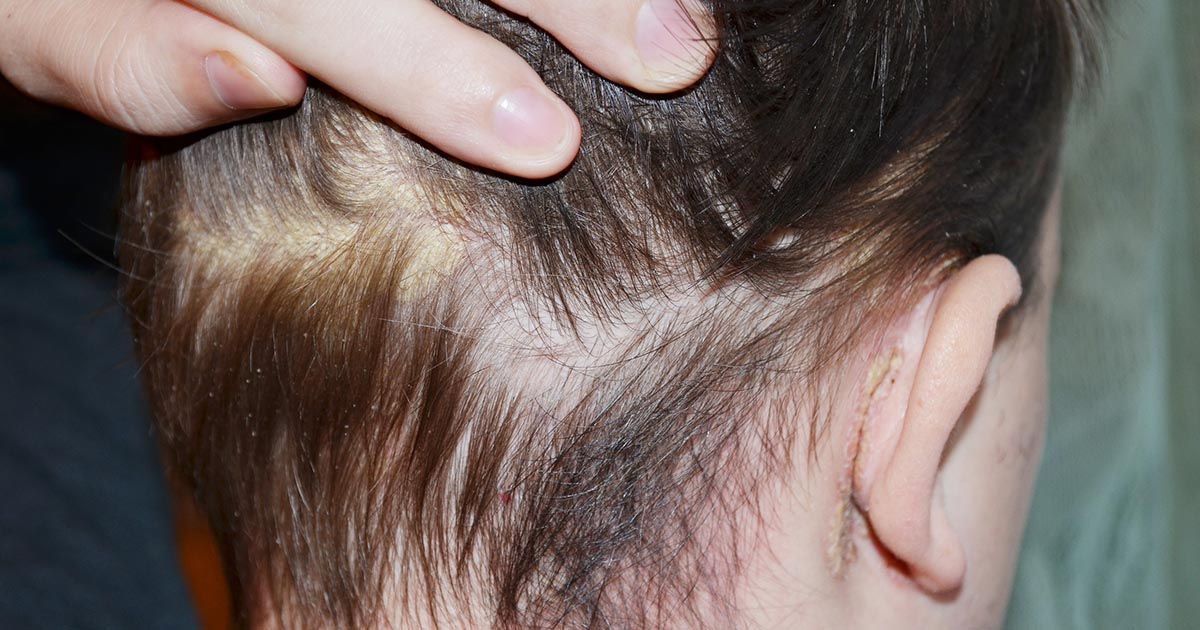Serious Symptoms Of Ear Cancer
Ear cancer is a term used to describe a malignancy that develops in the cells that form the tissues of the outer ear, ear canal, middle ear, or inner ear. The cause of ear cancer is not known due to its low prevalence, but several factors are known to increase an individual's risk. An ear cancer diagnosis is made with a physical examination, MRIs, CT scans, and a biopsy of the affected tissue. Ear cancer treatment options are based on the size and exact location of the tumor in the ear. The first line of treatment of ear cancer is surgical excision, and many cases require subsequent reconstructive surgery. Severe cases may require removal of the entire eardrum, ear canal, and surrounding bone. Ear cancer that affects the temporal bone or ear canal often requires radiation therapy following surgical excision.
Scaly Patches Of Skin

An individual who experiences the development of scaly patches of skin around or on the skin of the outer ear may be affected by ear cancer. The outer ear is the part of an individual's ear that can be seen from the outside. The primary functions of the outer ear are to help focalize and collect sound while protecting the rest of the ear. The outer ear has three different parts: the eardrum, ear canal, and ear flap. Ear cancer usually starts as a malignancy of the skin on the outside of the ear. The most prevalent types of skin cancers to appear on the outer ear, skin around the ear, and ear canal are referred to as basal cell carcinoma and squamous cell carcinoma. Basal cell carcinoma is the type more likely to produce scaly patches of skin upon the initial manifestation of the malignancy. The scaly patch is resistant to the effects of creams, moisturizers, lotions, and gels. As the tumor progresses, the scaly patch will gradually develop a pearly white colored bump underneath it.
Skin Ulcers

The development of skin ulcers on the region of skin that surrounds or makes up an individual's outer ear may indicate they are being affected by ear cancer. A sore around or on the outer ear that is chronically inflamed and does not resolve without treatment within four weeks is of considerable concern in regards to ear cancer. A sore or ulcer that does not heal is considered one of the most common symptoms that occur in affected individuals. A skin ulcer caused by ear cancer may spread from the face to the ear. A skin ulcer from ear cancer may crust over and begin to bleed with touch as it progresses. Squamous cell cancers can cause the development of cancer in or on the ear and have a cauliflower-shaped and or ulcerated appearance. Malignant melanoma may develop on the outer ear, and most commonly originate conspicuously in a hyperpigmented freckle, mole, or spot that begins to change shape, color, and consistency in borders. This pigmented spot continues to grow, may form a blister, may become itchy, and can ulcerate.
Hearing Loss

An individual who experiences hearing loss may have ear cancer. This symptom typically only occurs when an individual's cancer has spread into the middle or inner ear. Cancers that start in the salivary glands, earwax secreting glands, and sweat glands are known to produce hearing loss. An individual who has cancer that has infiltrated their temporal bone where the ear is housed may also experience hearing loss. Hearing loss is the result of the swelling of an individual's ear canal in some cases, where sounds are unable to penetrate through the obstructed space. Conductive hearing loss is the type of hearing loss that occurs when cancer or some other mechanism stops the sound from reaching the inner part of the ear where it is connected to the brain. Sensory nerve hearing loss can also occur in patients affected by cancer that causes damage to the auditory nerve. When cancer causes conductive hearing loss, it can sometimes be recovered. However, sensory hearing loss caused by any mechanism is usually permanent.
Discharge From The Ear

An affected individual may experience bloody or abnormal discharge from the ear as a symptom of their ear cancer. Discharge from the ear is a symptom that most commonly occurs in individuals affected by a form of ear cancer that is causing damage to the ear canal or middle ear structures. Discharge is a term used to describe when any type of liquid drains from the inside to the outside of an individual's ear. Malignancy that affects the skin of the individual's ear canal and middle ear is typically a form of carcinoma, either squamous or basal cell. These cancers of the skin cause ulceration and irritation of the surrounding tissues. Bleeding and discharge of fluid from the cancerous ulcer located in the ear canal is what the patient is observing when they have discharge from the ear. Cancerous lesions that cause an affected individual's eardrum to rupture or burst can also produce a bloody discharge.
Ear Pain

An individual who is experiencing ear pain may be affected by ear cancer. Ear pain that feels similar to what is produced by the common ear infection would be more indicative of a cancerous tumor or lesion growing in the tissues that make up the structure of the inner and middle ear. External ear pain is the result of skin type cancers that affect the skin around and on the pinna or ear fold. Pain from an inner ear tumor is the result of the cancerous growth taking up space in the brain that houses numerous other critical structures and increasing the overall pressure in the skull. A malignant tumor that forms in the structures of the inner ear is more likely to cause pain with pressure as well as changes in hearing, behavior, and facial nerve function. Cancer that occurs in the bone that houses the structures of the ear can also cause ear pain when it becomes larger and presses on the fragile structures and nerve fibers in and around the ear tissues.
Lumps Under Skin

An individual who experiences lumps under the skin of their outer ear may be affected by ear cancer. The lumps under the skin that develop due to ear cancer have been described to have a pearly white color to them and may range from the size of a small pimple to a grape. The pearly white lumps in ear cancer are most often found on the ear rim or pinna, outer ear canal entrance, and ear lobe. The most prevalent type of ear cancer that is known to produce these pearly lumps under the skin as an indicative symptom is referred to as squamous cell carcinoma. This type of cancer is technically cancer of the deeper layers of the skin that is referred to as ear cancer because it develops in the tissues of an individual's ear structure.
Numbness On Affected Side Of Head

The type of ear cancer known to produce numbness on the affected side of the head is usually located in an affected individual's middle or inner ear tissues, behind their eardrum. The main nerve that provides the communication pathway of information between the individual's ear and brain is close in proximity to a nerve referred to as the facial nerve. The facial nerve is responsible for the operation of the muscles that produce facial expression, eye closure, wrinkling of the forehead, and raising the eyebrows. Cancer in the ear can grow into a large tumor that compresses the nearby facial nerve. When this nerve becomes compressed or damaged from the cancerous growth in the inner or middle ear, patients can experience numbness and tingling on the affected side of their head.
Ringing In The Ears

An ear cancer patient may have the perception that they are hearing sounds best described as hissing, ringing, roaring, whistling, or buzzing. The sound an affected individual feels they are hearing may be intermittent or constant. Most individuals who experience this manifestation of ear cancer are hearing these sounds in the affected ear when no external auditory sounds are present. The sounds in the ear of an individual affected by ear cancer often beat in synchronization with their heartbeat. This ringing in the ears may only be obvious when the affected individual is in a quiet environment. Cancer growing in the middle or inner ear can cause ringing in the ears through the blockage of the ear canal or by causing damage to the sound-sensitive cells that make up the individual's cochlea.
Dizziness

Feelings of dizziness, disequilibrium, and vertigo are most commonly found in cancer that affects the inner ear. These symptoms develop in an individual when their ear cancer grows directly into their vestibular nerve or grows to the point where it compresses their vestibular nerve. The vestibular nerve is responsible for the communication of information to and from the brain that helps with maintaining balance and providing the correct perception of the position and orientation of the body relative to its surroundings. This mechanism does not cause a total loss of balance and equilibrium, as the other vestibular nerve on the unaffected side of the brain can compensate. However, this compensation is often not enough to keep away unsteadiness and dizziness.
Headaches

Cancer in the ear can grow large enough to where it comes in contact with and presses on the dura, the lining of the interior of the skull. The brain tissues do not have sensory nerve fibers and are not the cause of headaches in cancers that affect the head and neck. Sensory fibers in the dura can sense pressure from the growing tumor in the affected individual's inner ear. This sensory information regarding the compression of the nerve fibers is interpreted by the brain as pain and produces a headache. The headaches that develop due to ear cancer are usually unilateral, meaning they only occur on the affected side of the head. Many individuals who have experienced this symptom describe the headache pain to have dull or achy qualities and can radiate to the front of the head, neck, or top of the head.
